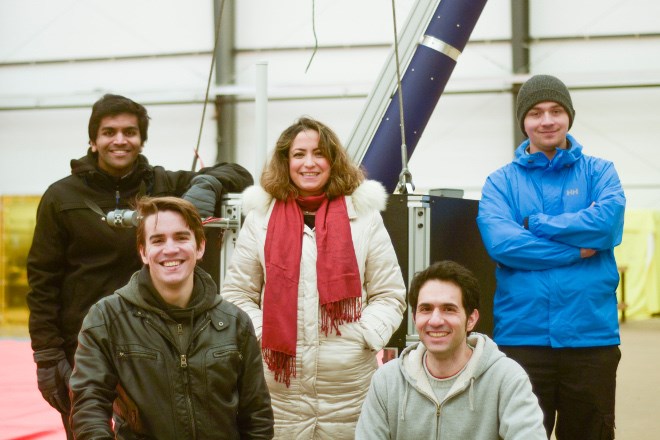SpaceRyde is vying to be one of the first Canadian companies to launch small satellites into space, and North Bay’s Jack Garland Airport is playing a key role in helping the company get there.
In the early morning hours of June 9, a small team of five from the Toronto-based company gathered at the North Bay airfield to complete the first test flight on a small-scale version of their launch system.
So, of all the places in Ontario where they could be launching satellites, why North Bay?
Saharnaz Safari, SpaceRyde’s chief operating officer, said in the course of researching appropriate locations for the launch, the team was introduced to Kelly Hewitt, the airport’s commercial development manager, and they started a conversation about how Jack Garland Airport could participate.
“When you talk about balloons, and rockets launching from balloons, and even rockets being on board, not everyone is happy to hear that,” Safari said, noting the risk involved in launching a projectile like a rocket into the sky.
“Kelly and the other staff at North Bay Airport, they were different. They liked the idea, they wanted to help, they wanted to bring more business for North Bay, and so it worked out well.”
Jack Garland’s location just a few hours’ drive from Toronto meant the SpaceRyde team could easily transport its rocket and launching equipment up the highway. The team also needed a spot that was flat and road-accessible so they could get their equipment to the site.
North Bay’s airport checked all the boxes.
It’s not the first time an out-of-town company has eyed the airport for satellite-launch testing.
In 2014, Swiss Space Systems (S3) announced a partnership with Canadore College to set up a test site for its rocket-launch technology, with the aim of offering zero-gravity flights by 2017.
But just two years later, S3 declared bankruptcy, and the project was cancelled.
Want to read more stories about business in the North? Subscribe to our newsletter.
The satellite technology of today has vastly changed from that of the 1980s, when large, hulking multi-million-dollar satellites developed by government agencies were the norm.
Today, private companies are using small satellites – defined as weighing anywhere between 44 pounds and 1,100 pounds – to primarily serve three industries: telecommunications, observation, and remote sensing, Safari said.
A cluster of the smaller-sized satellites, called a constellation, shot into orbit can last two to three years before they start to break down and have to be replaced.
But one issue remains: how to efficiently get the satellites into space.
Currently, small satellites can hitch a ride on a rocket flown by a larger company like SpaceX in the U.S. or RocketLab in New Zealand.
But it’s complex, inefficient and expensive, Safari said.
“It's like a bus: you cannot determine the schedule; the schedule is determined by the primary payload, which is a huge satellite that's going up,” Safari explained. “And also the destination is determined by that.”
That’s where companies like SpaceRyde come in.
As an alternative to the current ridesharing-type service, SpaceRyde proposes customized trips – like those delivered by a taxi or Uber – that would allow private companies to book a rocket at a scheduled time, for a specific orbit and destination.
Rockets carrying the satellites are launched via balloon, closer to the earth.
“With a balloon ride, you go to the edge of the atmosphere,” Safari explained. “By clearing the majority of the atmosphere with the balloon ride, you're not exposing the rocket and the satellite into high vibrations and the heating that happens from the rocket moving through the atmosphere at high speed.”
Without requiring a launch pad, towers, and other traditional infrastructure associated with a launch, it also makes this method more affordable for the average company to use, Safari said.
SpaceRyde’s June test flight served primarily to showcase some of the proprietary software technologies the company has developed, including stabilizing the gondola after it’s launched, so the rocket can be pointed in the right direction toward its destination.
“If you don’t have this technology built, it’s like you’re launching a rocket from a trampoline,” Safari said. “It won’t get to the destination that you want.”
On-board computers use a built-in algorithm to continually calculate the rocket’s path, and the communications system allows the SpaceRyde team to have uninterrupted contact with the rocket, which is essential if the team needs to abort the mission and land the rocket safely.
Testing on the systems will continue, and Safari said the next big milestone will be firing the rocket from a full-scale gondola system, which will lead, eventually, to sending those rockets, and the accompanying satellites, into space.
The company is also in hiring mode, looking to add four full-time positions to its current crew of nine.
Safari is most proud that this technology is being developed in Canada, and believes North Bay has played a critical role in advancing the country’s capacity as a central player in rocket-launch technology.
“I think North Bay is going to be in the history of Canada’s launch capability forever, because the first flight happened from North Bay,” said Safari, suggesting that SpaceRyde team members could return for future testing.
“We had a great experience at YYB, so that’s a good possibility.”




